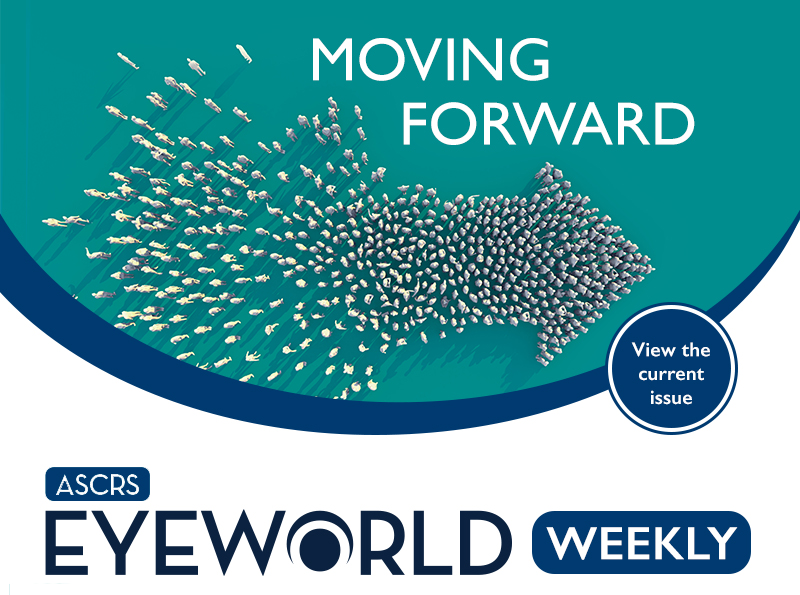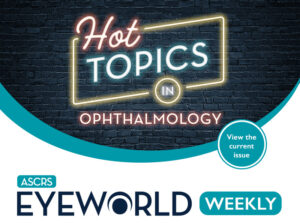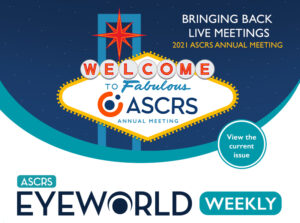
- 2021 ASCRS Annual Meeting update
- FDA approves new monofocal IOL
- First patient dosed in Phase 2 trial for investigational DED therapy
- Phase 2a trial initiated for add-on wet AMD therapy
February 5, 2021 • Volume 27, Number 5
2021 ASCRS Annual Meeting update
The 2021 ASCRS Annual Meeting will now take place July 23–27 in Las Vegas, Nevada. The meeting was previously scheduled to take place in August in San Francisco, California, but COVID-19 restrictions made holding a meeting there unfeasible. The Mandalay Bay Convention Center in Las Vegas will now host the 3-day main program, along with Subspecialty Day on Friday, July 23, and the new Eyecelerator Innovation Conference on Thursday, July 22. Registration will open February 22 and housing will soon follow. For more information, visit annualmeeting.ascrs.org.
FDA approves new monofocal IOL
The FDA approved the new TECNIS Eyhance and TECNIS Eyhance Toric II IOLs by Johnson & Johnson Vision, with the company describing the IOLs as next-generation monofocal lenses. The Eyhance IOLs have a unique shape that allows for “slightly extended depth of focus” and better low-light image contrast, according to the company’s press release. The Toric II version has a squared edge and frosted haptics to increase friction and stabilize the IOL. TECNIS Eyhance launched in 2019 in Europe and became commercially available in Latin America and Canada in 2020. Eyhance and Eyhance Toric II are now commercially available in the U.S.; the toric version will become commercially available in Europe and Canada later this year, according to Johnson & Johnson Vision.
First patient dosed in Phase 2 trial for investigational DED therapy
Surface Ophthalmics announced the first patient dosed in its Phase 2 clinical trial for SURF-100 (mycophenolate sodium and betamethasone sodium phosphate in Klarity vehicle) as an investigational treatment for chronic dry eye disease (DED). According to the company’s press release, SURF-100 will be compared to lifitegrast ophthalmic solution 5% and cyclosporine ophthalmic emulsion 0.05% in the trial, which will enroll about 300 patients. The primary endpoint will be a statistically significant improvement in symptoms based on the University of North Carolina Dry Eye Management Scale at day 84.
Phase 2a trial initiated for add-on wet AMD therapy
Gemini Therapeutics announced a Phase 2a clinical trial that will evaluate GEM103 as an add-on therapy for patients with wet AMD who either have macular atrophy (or may be at risk for it) and who require ongoing anti-VEGF treatment. According to the company’s press release, there is no current therapy or preventative measure for macular atrophy that can occur in these patients. GEM103 is described as a recombinant human complement factor H protein that could address the lower CHF activity that has been associated with ongoing anti-VEGF therapy. The company stated that GEM103 could address the unmet need in a genetically defined subset of AMD patients who have a mutation in their complement factor H gene. The current clinical trial is randomized, single masked, and sham controlled; safety, tolerability, effect on CFH levels, and disease-relevant biomarkers will be assessed, the company’s press release said.
Research briefs
- Research published in Stem Cell Reports provided proof-of-concept for a gene therapy that could be used to treat dominant CRX mutations that cause Leber congenital amaurosis (LRA) and other CRX retinopathies. The investigators used induced pluripotent stem cells from two patient volunteers with a CRX mutation to create an in vitro model of CRX-LRA in retinal organoids. They then used AAV-mediated CRX gene augmentation therapy and partially restored expression of phototransduction genes, the study reported.
- A study published in Clinical Ophthalmology looked at the unintended ocular consequences that could result from delaying care during the COVID-19 pandemic closure. This cross-sectional, retrospective review of data from a single-provider outpatient clinic specifically looked at patients who receive regular intravitreal injections of anti-VEGF or corticosteroids. The review took place over 6 weeks in consecutive patients following reopening of elective procedures, and patients were marked as either having care delayed (follow-up of at least 33% longer than intended) or undelayed. Main outcomes were BCVA and OCT of intraretinal or subretinal fluid. Data from the same time period of the previous year (2019) served as a control comparison. A total of 183 eyes were included in the study period (193 as a control in 2019), 62 of which were considered delayed. The investigators found that about 15% of patients were “delayed” as a result of the pandemic shutdown. Those in the delayed group had greater BCVA decline and were more likely to have worse OCT results. The study authors concluded that consequences of delayed care due to the pandemic should be anticipated and mitigation strategies should be developed if a similar delay of care happens again.
- A report published in the journal Cornea discussed an observation while using Scheimpflug densitometry on keratoconic corneas. The observation was that Scheimpflug densitometry analysis seemed to delineate the base of the cone in the area of the cornea affected. The investigators looked at Scheimpflug densitometries of 20 normal corneas and 90 from patients with keratoconus. The researchers observed a “bright area” in the densitometry map in the cone location on 88 of the 90 keratoconus cases. Characteristics such as brightness and contrast also correlated with keratoconus severity, the authors noted. Changes over time were observed. Densitometry maps of normal corneas did not show such features. With these findings, the researchers wrote that densitometry maps could be used as a supplementary tool for documenting the stage of keratoconus. They also advocated for future studies to look into whether this feature could be used in keratoconus detection, progression, or other corneal biomechanical behavior.
Product news
- Alcon’s Clareon IOL and the AutonoMe delivery system launched in Canada.
This issue of EyeWorld Weekly was edited by Stacy Jablonski and Liz Hillman.
EyeWorld Weekly (ISSN 1089-0319), a digital publication of the American Society of Cataract and Refractive Surgery (ASCRS), is published every Friday, distributed by email, and posted live on Friday.
Medical Editors: Eric Donnenfeld, MD, Chief Medical Editor; Rosa Braga-Mele, MD, Cataract Editor; Clara Chan, MD, Cornea Editor; Nathan Radcliffe, MD, Glaucoma Editor; and Vance Thompson, MD, Refractive Editor
For sponsorship opportunities or membership information, contact: ASCRS • 12587 Fair Lakes Circle • Suite 348 • Fairfax, VA 22033 • Phone: 703-591-2220 • Fax: 703-591-0614 • Email: ascrs@ascrs.org
Mention of products or services in EyeWorld Weekly does not constitute an endorsement by ASCRS.
Click here to view our Legal Notice.
Copyright 2021, EyeWorld News Service, a division of ASCRSMedia. All rights reserved.


